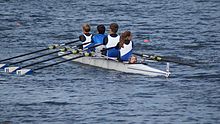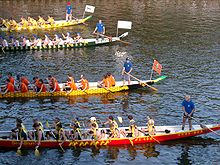Helmsman (rowing)
A coxswain (including coxswain , control ling or plural helmsmen ) in certain boat classes in canoeing and rowing a member of the boat crew. His participation in the movement of the boat takes place by giving commands . He often guides the boat with the help of a steering device . He is responsible for the safety of the team.
In canoe racing and rowing, the helmsman also gives tactical commands - such as intermediate sprints or an increase / decrease in the stroke frequency - to the athletes while observing the course of the race . He cheers on the team for the entire race and provides information on the route to be mastered and the position of the team in the race. In the dragon boat , the racing tactics are the task of the drummer, who also makes the announcements over an intercom.
Boat classes with a helmsman are various team boats in rowing, all dragon boats and the eight-canoe in canoe racing . In boats without a helmsman, another crew member takes over the control of the boat.
Rowing
Minimum weight
In rowing regattas , helmsmen must have a minimum weight of 55 kg in order to be allowed to start. An underweight of up to 15 kg can be compensated for by carrying additional weights.
position


In rowing boats there are two different places for the helmsman: in gig boats and many older, mostly wooden racing boats, the helmsman sits in the stern of the boat behind the entire crew. The area in front of the bow of the boat is therefore difficult to see for the helmsman and is therefore occasionally monitored by the athlete sitting in the bow. In contrast, the advantage of placing the helmsman in the stern is the direct contact with the crew in front of him.
In racing rowing, it is particularly advantageous to position the helmsman lying down in the bow box in a two-man with a helmsman and in a four-man with a helmsman for reasons of optimal weight distribution. This fact was discovered by Georg von Opel in the 1950s . The helmsman can then see the area in front of the rowing boat, but he must have a good feeling for the width of the boat including the sculls or oars . With an intercom system consisting of a microphone and loudspeakers in the hull, the so-called Cox-Box , the helmsman can give instructions to the rowers from this position that he cannot see.
In the aft , the influence of the position of the helmsman on the weight distribution is small because of the boat's length of around 17 meters. Because of the enormous difficulties in steering an aft from the bow position, as well as for safety reasons, the helmsman in the aft is usually placed in the stern. A cox box with two to four loudspeakers in the crew room is still often used, as the rowers in the bow can otherwise hardly hear the helmsman. In the past, speaking tubes were used in the figure eight instead of the electric Cox box.
Control devices
If the helmsman sits in the stern, he usually controls the boat using a wire rope that is stretched on both sides of the seat and leads to the stern of the boat, where the rudder is attached. If the helmsman is in the bow, the so-called steering line is pulled through the entire hull and crossed at the stern. There is a lever in the bow that moves the rope. Crossing is necessary so that the end of the lever always points in the direction in which the boat is currently going. This makes steering a lot easier.
Boats with a helmsman
Boats without a helmsman
In boats without a helmsman, one of the rowers is the boat manager and is responsible for safety. The bowman sitting in the bow regularly looks around and gives instructions in which direction the boat should steer. The change of direction can then take place via a foot control , which is operated by one of the rowers with the foot and is attached to his stretcher , or by pulling the oar blades on one side. Boats without a helmsman are:
Canoeing
In the aft canoe and in the dragon boat, the helmsman is always in the stern. The canoe is steered with a control paddle. Dragon boats are controlled with an approx. 3 m long rudder that is attached to a steering handle protruding across the boat.
Individual evidence
- ↑ Wolfgang Fritsch: Handbook for rowing . 4th edition. Meyer & Meyer Verlag, Aachen 2006, ISBN 978-3-89899-111-7 , p. 88-91 .
- ↑ bbc.co.uk: How the eight works. Retrieved December 12, 2012 .
- ↑ a b Volker Grabow: Basic course in rowing - materials for rowing training. (PDF; 1.6 MB) (No longer available online.) Archived from the original on July 15, 2014 ; Retrieved December 12, 2012 . Info: The archive link was inserted automatically and has not yet been checked. Please check the original and archive link according to the instructions and then remove this notice.
- ^ FISA Rule Book. (PDF; 2.95 MB) In: www.worldrowing.com. World Rowing Association , p. 53f. , accessed September 20, 2019 .
- ↑ Volker Nolte: Forward Thinking: Coxswains have been lying down on the job for more than 50 years; but is a box-coxed boat really faster? In: Rowing News . tape 13 , no. 12 , 2007, p. 68-71 .
